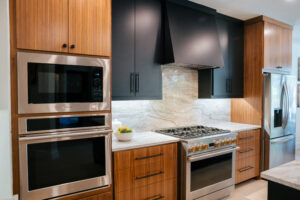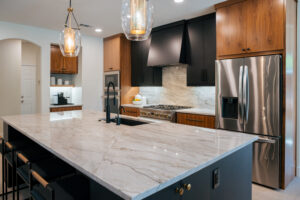Slab Doors in Kitchen Remodeling: How Wood Flat-Panel Design is Replacing the Shaker Era
 The kitchen and bath design world is experiencing a seismic shift as slab doors emerge as the bold new standard, systematically replacing the Shaker door dominance that has defined residential kitchen renovations for the past two decades. This transition represents more than just a stylistic preference – it signals a fundamental change in how homeowners approach their living spaces, prioritizing trendy minimalism over traditional detailing.
The kitchen and bath design world is experiencing a seismic shift as slab doors emerge as the bold new standard, systematically replacing the Shaker door dominance that has defined residential kitchen renovations for the past two decades. This transition represents more than just a stylistic preference – it signals a fundamental change in how homeowners approach their living spaces, prioritizing trendy minimalism over traditional detailing.
The End of an Era: Shaker Doors Lose Their Grip
For nearly twenty years, Shaker-style doors ruled supreme in American kitchen remodeling design. Their clean recessed panel, simple frame construction, and modest ornamentation struck the perfect balance between traditional craftsmanship and contemporary sensibilities. Shaker doors became the safe choice – elegant enough for upscale homes yet accessible enough for mainstream adoption. Homeowners loved the range of choices within the aesthetic.
However, the kitchen design landscape has evolved dramatically. What once felt fresh and modern now appears dated and predictable. The five-piece construction of Shaker doors, with their raised frames and recessed panels, increasingly feels fussy and over-detailed with homeowners who celebrates clean lines and simplicity in their kitchens. Flower Mound and Highland Village residents who once gravitated toward Shaker doors are now viewing them as remnants of a bygone aesthetic, much like how Shaker doors themselves displaced the ornate raised-panel doors of the 1990s.
The shift away from Shaker styling may reflect broader cultural changes. As our lives become increasingly complex and digitally saturated, there’s a growing desire for physical spaces that offer visual calm and mental clarity. In any case, we’re excited to offer these sleek and attractive door options for your kitchen remodel.
What Are Wood Slab Doors?
Wood slab doors are single, flat panels of high quality wood that present completely smooth, uninterrupted surfaces. This streamlined approach eliminates every unnecessary element, creating pure, geometric forms that speak to contemporary design sensibilities.
The beauty of wood slab doors lies in their ability to showcase the natural material itself. Without frames, reveals, or panel details to distract the eye, the wood grain becomes the primary visual element.
This brings in another design trend that’s happening now: stained cabinet surfaces, replacing painted cabinets.
The kitchen renovation you see pictured on this page uses slab doors made from walnut, but stained lighter, where the range hood is a rich contrasting dark brown stain, still using slab doors on the adjoining upper cabinet doors. This contrast is a bold and beautiful touch in this kitchen design.
This focus on material authenticity aligns perfectly with current design trends that emphasize natural elements, sustainable materials, and honest construction. Wood slab doors don’t try to be anything other than what they are – beautiful pieces of wood, expertly crafted and simply presented.
Modern Clean Lines in Kitchen Renovation Design: Why Wood Slab Doors Are Dominating
Clean, Contemporary Aesthetics
The primary force driving the slab door revolution is the growing preference for visual simplicity and spatial clarity. While Shaker doors create visual rhythm through their repeated frame-and-panel pattern, this rhythm now feels busy and dated compared to the serene uniformity of slab doors. The flat surfaces create unbroken visual planes that make kitchens and bathrooms appear larger, more organized, and inherently more sophisticated.
This trendy approach perfectly supports popular design movements like Scandinavian minimalism, Japanese-inspired interiors, and contemporary lodge style. The absence of traditional door detailing allows other design elements – natural stone countertops, dramatic backsplashes, sculptural lighting, and architectural hardware – to command attention without competing visual elements.
Showcasing Natural Wood Beauty
One of the most compelling aspects of wood slab doors is their ability to celebrate the inherent beauty of wood grain patterns. Shaker doors, with their frame-and-panel construction, often fragment and interrupt wood grain patterns. The panel might showcase beautiful grain, but the surrounding frame creates visual boundaries that limit the wood’s impact.
Slab doors eliminate these interruptions, allowing wood grain to flow continuously across entire cabinet runs. This creates dramatic visual effects, particularly with species known for distinctive grain patterns. A kitchen featuring book-matched walnut slab doors can display grain patterns that sweep across multiple cabinet doors like abstract artwork, creating a bold and elegant focal point that would be impossible to achieve with traditional frame-and-panel construction.
The Transition from Shaker to Slab
The shift from Shaker to slab represents more than changing fashion – it reflects evolving lifestyle priorities and aesthetic values. Shaker doors emerged during an era when “transitional” design was king, offering a bridge between traditional and contemporary styling. They provided enough detail to satisfy those seeking craftsmanship evidence while remaining clean enough for modern sensibilities.
Today’s homeowners are more decisive in their aesthetic choices. The middle-ground approach that made Shaker doors so popular now feels like compromise rather than sophistication. Modern homeowners want spaces that make clear design statements, and the bold simplicity of slab doors delivers this decisively.
The transition is also being driven by a new generation of homeowners who didn’t experience the cabinet trends of previous decades. For them, Shaker doors don’t represent a clean departure from ornate traditional styling – they simply appear as outdated as the raised-panel doors they once replaced.
Design Integration in Modern Kitchens
In kitchen applications, wood slab doors are revolutionizing cabinet design by creating seamless integration with contemporary architectural elements. Open-concept layouts demand visual continuity, and the clean lines of slab doors support this far more effectively than the busy repetition of Shaker frames and panels.
Many designers are using wood slab doors to create striking monochromatic environments where the wood species becomes the primary design element. A kitchen featuring consistent white oak slab doors from floor to ceiling creates a sophisticated, spa-like environment that feels both trendy and timeless. The natural wood grain provides all the visual interest needed without additional ornamentation.
Wood slab doors also work exceptionally well in mixed-material applications. Pairing wood slab doors with sleek stone countertops, metal accents, and glass elements creates sophisticated contrasts that highlight each material’s unique characteristics. This approach feels fresh and current compared to the more predictable combinations typically seen with Shaker styling.
Bathroom Applications
In bathroom environments, wood slab doors are proving equally transformative. The clean lines help smaller bathrooms feel more spacious and organized, while the natural wood brings warmth to spaces that might otherwise feel cold or clinical. The lack of frame details also makes wood slab doors easier to maintain in humid environments, as there are fewer places for moisture to accumulate.
The elegant simplicity of wood slab doors supports the growing trend of creating spa-like bathroom retreats. Combined with natural stone, quality hardware, and carefully chosen lighting, wood slab doors help create the serene, resort-like atmosphere that modern homeowners increasingly desire.
Practical Advantages Over Shaker
Beyond aesthetic considerations, wood slab doors offer several practical advantages over their Shaker predecessors.
Maintenance is simplified, because they are far easier to clean. The flat surfaces are easier to wipe down than frame-and-panel construction, which can trap dust, grease, and moisture in the reveals between frames and panels. This is particularly valuable in kitchen environments where cleanliness and hygiene are paramount.
The Future of Cabinet Design
As we look ahead, the dominance of wood slab doors appears likely to continue and expand. The bold choice to embrace radical simplicity represents a mature design aesthetic that prioritizes quality materials, expert craftsmanship, and timeless forms over trendy details that quickly become dated.
The shift from Shaker to slab doors represents more than just changing fashion – it reflects a fundamental evolution in how we think about our living spaces. As homeowners continue to value authenticity, simplicity, and natural materials, wood slab doors offer a perfect expression of these priorities.
For those considering a kitchen remodeling project, choosing wood slab doors over traditional Shaker styling represents an investment in a design approach that feels both current and enduring – a rare combination that positions these spaces to remain relevant and beautiful for years to come. The Shaker era has ended; the age of sophisticated simplicity has begun.
